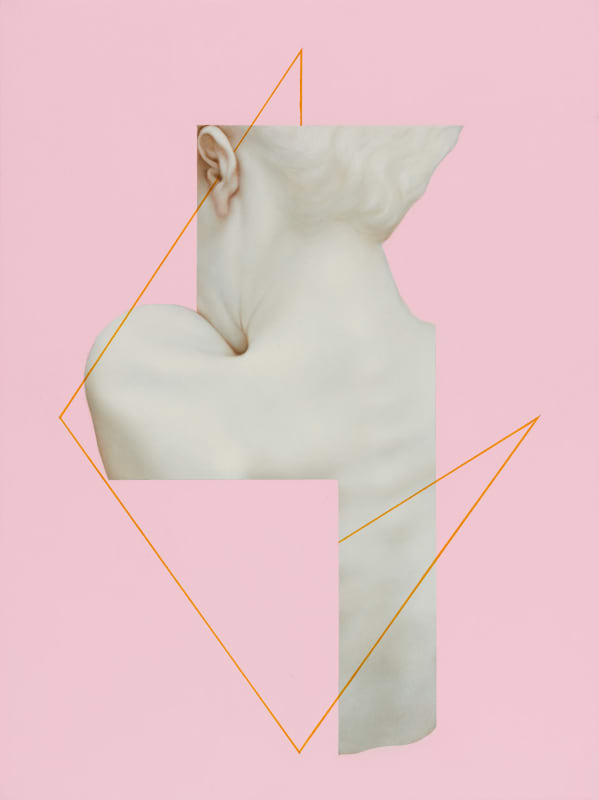Private View: 13th of March, 18:30 - 21:00
Fragmented, warped and isolated body parts unite the artistic practises of Juliette Mahieux Bartoli and Athar Jaber for their first ever duo exhibition at Kristin Hjellegjerde Gallery Berlin. The show’s title ‘NONSEQUITUR’, a Latin phrase meaning it does not follow logically, functions as a discussion point around which the distinct artworks simultaneously juxtapose and converse, thus interrogating the ways in which we view and interact with art, and also providing the potential for new perspectives.
Juliette Mahieux Bartoli’s vibrant, abstract paintings break apart the human body to create new space and forms. The artist connects classical motifs to questions of multicultural identity and belonging creating a unique visual language. The colour palette is distinctly Roman, recalling ochre buildings, pink skies, cobbles and marble, whilst the fragmentation of the human body mimics the city’s architectural melding of old and new. ‘If visual composition is treated like language, images can be fragmented to a point where meaning is retained in a concentrated form — such as a hand or a head,’ commented the artist. ‘The fragments, like words, can be reassembled in infinite variations to produce legible meaning, playing on both the viewers’ associations and the homonymic nature of the fragments.’
In this way, Mahieux Bartoli invites the viewer to explore multiple readings of each painting. These readings can be split into three layers: literal, rhythmic (in which the abstract pieces can be reassembled according to lyrical impulse) and finally, analytic (where the viewer questions how they make these decisions and how this manipulates the meaning). The titles of the works are all drawn from literary theory terminology, further emphasising the connection between visual and language. For example, the triptych ‘XP -> (SPEC) X̅ YP* (X-bar theory)’ gives a set of the visual elements, each possessing internal meaning, that tell a more complex narrative when united. The piece is designed to be rearranged to enable different understandings. ‘What the triptych does is a blueprint for the NONSEQUITUR body of work as a whole,’ comments Mahieux Bartoli. ‘It is an exercise in visual verse: the series of eight pieces is created as a whole, though the pieces, apart from the diptych, can be divided or separated out. Each piece can be joined with one or more others in a variety of orientations and distances.’
Through the practice of stone carving and sculpture, Jaber also takes the human body as a motif. Fascinated by the ancient tradition of donating representations of body parts (often in the form of sculptures or paintings) to Gods, either to ask for healing or as an expression of gratitude, Jaber considers dynamics of violence sensed both in our relationships with ruling authorities, such as divinities and governmental bodies as well as in the symbolic severing of the human body. Sculpting isolated body parts from white marble, the artist creates an eerie and distancing effect; whilst we might, for example, recognise a pair of ears, we view them differently when they are removed from the context of the head. Thus, challenging our perceptions of the human body.
Alongside these detached body parts, Jaber has created a series of four reliefs, each representing a child’s head with an ‘erased’ face. This destruction references iconoclastic practises as well as the contemporary practise of censoring children’s faces in media. Whilst the censorship is employed to protect children’s identities, in the process the image must be manipulated to the extent that the human face is no longer recognisable. As such, the artist invites us to consider contemporary manifestations of ancient practises and also new forms of violence.
Jaber also presents a triptych of handprints engraved into marble. Reminiscent of sacred stones that exhibit indents left by various religious leading figures, the artist explores the ways in which natural stones become artworks and relics to be worshipped. This notion of engraving also references the carvings made by the earliest civilisations and the universal desire for humans to leave behind some mark or legacy to confirm their existence. One of Jaber’s featured slate stone engravings invites exhibition viewers to do exactly that; the engraving is derived from a Roman mosaic, reading ‘Envy, I tread on you’, and sits on the gallery floor for visitors to walk over. Eventually, their footsteps will further shape the stone and they will become the artists.
Although the works by Louise Thomas, presented in the Discovery Room, do not portray persons, they are a playful reference on movements of human body in space.
Individual components in her paintings such as landscape, plants or architectural elements may (at second sight) leave the impression to be connected to different places all over the world and not to exist in that composition in reality. This is the result of Thomas
bringing together memory fragments of different places (she has visited) in new assemblages.
The artist allows various dimensions of space and time to merge to a new unit. Viewers can explore the venues inside the paintings
and thus the artist’s memory while they are free to decide where single fragments do have their origin.




